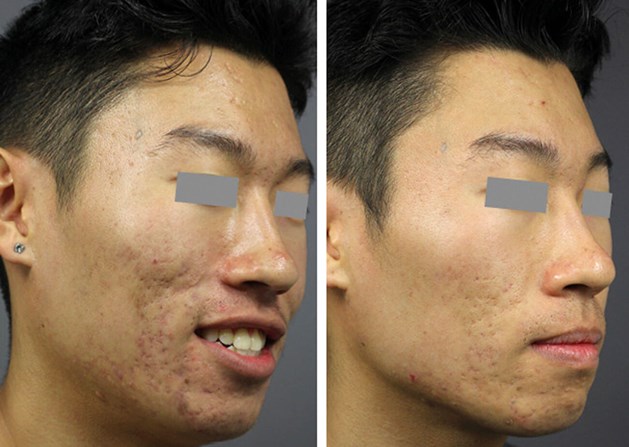Exploring Skin Disease: Treating and recognizing Acne Scars for Healthier Skin
Acne scars represent a significant worry for individuals seeking to keep healthy skin, as they can affect both appearance and self-worth. Comprehending the various types of marks, from atrophic to hypertrophic, is crucial for identifying ideal therapy choices.
Understanding Acne Scars

The body's all-natural healing procedure can lead to either atrophic scars, which appear as depressions in the skin, or hypertrophic scars, which are raised and arise from overflow of collagen. In addition, the psychological toll of acne marks need to not be taken too lightly; numerous people report feelings of humiliation, anxiousness, and reduced self-confidence. This emotional concern can affect social interactions and general top quality of life.
Addressing acne marks requires an extensive understanding of their formation and effect. Understanding of the possibility for lasting effects related to neglected scars can motivate individuals to seek suitable treatments. Early intervention and effective administration methods can dramatically improve skin look and boost emotional resilience, emphasizing the value of recognizing the intricacies surrounding acne scars.
Kinds Of Acne Marks
Acne marks can be classified right into distinctive kinds, each exhibiting unique qualities and requiring particular treatment methods. acne scars treatment. The key sorts of acne marks consist of atrophic, hypertrophic, and keloid marks

Hypertrophic scars, in comparison, are raised over the skin level and are the outcome of excessive collagen manufacturing during the recovery process. They generally continue to be within the limits of the initial acne lesion. Keloid marks are similar yet expand past the original injury website, creating larger, elevated areas that can be scratchy or painful.
Comprehending these kinds of scars is crucial for selecting proper treatment alternatives. Various scars might respond much better to details therapies, such as laser therapies, fillers, or surgical interventions, stressing the importance of a customized strategy to acne scar administration.
Determining Your Scars
Acne scars usually drop into two classifications: atrophic and hypertrophic scars. These can additionally be identified into ice-pick scars, boxcar marks, and rolling marks, each exhibiting unique features and needing various methods for assessment.
Hypertrophic scars, on the other hand, are increased and happen as a result of excessive collagen production throughout the recovery procedure. Identifying the specific attributes of your scars-- such as deepness, appearance, and width-- is vital for proper recognition (acne scars treatment). Additionally, consider the distribution of scars across your skin, as this can indicate the severity and period of the acne problem
Involving with a skin doctor can give useful understandings into the nature of your scars, helping in the differentiation between various kinds. A thorough understanding of your scars will inevitably bring about a more customized and reliable therapy strategy, making certain a more clear and much healthier article source skin tone.
Treatment Options Available
Recognizing the specific kind of acne scars existing on your skin lays the groundwork for checking out effective treatment options. Common kinds of acne marks consist of atrophic (clinically depressed), hypertrophic (increased), and post-inflammatory erythema.
For atrophic scars, alternatives such as chemical peels, microneedling, and laser resurfacing are commonly made use of. Chemical peels utilize acids to get rid of the outer layer of skin, advertising brand-new cell read the article growth.
Hypertrophic marks can be treated with corticosteroid shots to squash the mark or laser therapy to reduce redness and boost look. Silicone gel sheets and pressure dressings may additionally help in managing elevated scars.
In addition, facial fillers can briefly fill out clinical depressions from atrophic marks, while medical excision may be appropriate for serious situations. Each treatment alternative has its considerations and benefits, making it important to speak with a skin doctor. They can supply customized recommendations based upon the kind and severity of your marks, as well as your skin kind and general health.
Tips for Prevention
Reliable avoidance techniques can dramatically decrease the possibility of developing acne scars. Using non-comedogenic products helps prevent clogged up pores, which can exacerbate acne.
Avoiding the desire to pop or choose acne sores is vital, as this can cause deeper skin damages and enhance the risk of scarring. Instead, think about using a cold compress or over-the-counter therapies to minimize swelling and soreness.
Sun security is an additional important aspect of prevention; ultraviolet (UV) rays can dim marks and prevent the healing procedure. Using a broad-spectrum sunscreen with at the very least SPF 30 daily can shield the skin and promote even healing.
Last but not least, keeping a balanced diet regimen rich in antioxidants, vitamins, and minerals supports skin health and wellness and healing. Staying hydrated and managing tension levels can also play a substantial function in minimizing acne flare-ups. By carrying out these strategies, people can dramatically lessen look at this web-site their possibilities of developing acne scars.
Final Thought
In final thought, understanding and determining acne scars is important for reliable therapy and accomplishing much healthier skin. Different types of acne marks, consisting of hypertrophic and atrophic scars, necessitate certain treatments customized to specific needs.
The body's all-natural recovery procedure can result in either atrophic scars, which show up as clinical depressions in the skin, or hypertrophic marks, which are elevated and result from overflow of collagen. They are additional divided right into three subtypes: ice choice scars, boxcar marks, and rolling marks. Acne scars normally fall into two classifications: hypertrophic and atrophic marks. These can additionally be classified right into ice-pick scars, boxcar marks, and rolling scars, each showing distinct characteristics and calling for different approaches for analysis.
Various types of acne scars, including hypertrophic and atrophic scars, necessitate specific treatments tailored to individual demands.